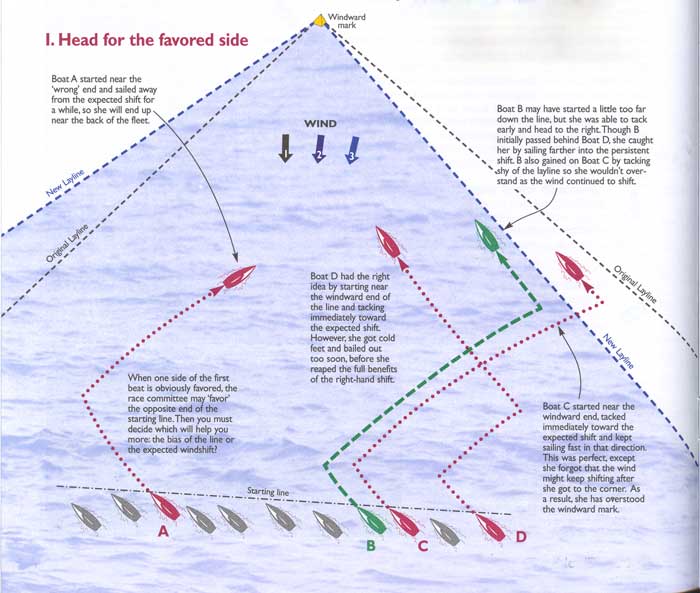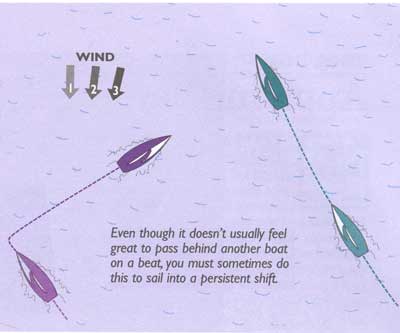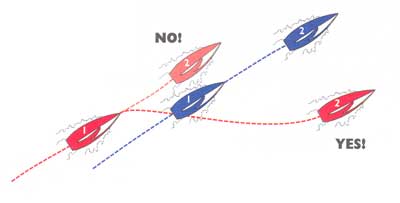by David Dellenbaugh
There are three basic types of windshift patterns that you may encounter on the race course: oscillating, persistent or unknown. When the wind directions shifting back and forth, you should follow all the oscillating strategies.
When you’re not sure what the wind will do, you should also use those
oscillating strategies. There are two reasons for this: First, it’s more common
to have oscillating shifts, so this should be your ‘default’ pattern unless you
find otherwise. And second, when you don’t have a great feel for the wind
pattern you should be a little more conservative; that’s what oscillating
strategies tend to be.
 |
However, when you know the wind will shift primarily in one direction during the
race (or during the next windward leg), you need a different approach. Here are
some critical ingredients of a strategy for playing persistent shifts.
Head for the shift.
Some elements of your strategic plan are the same for both oscillating and
persistent windshifts. The primary rule of thumb is that you should always sail
toward the next shift you expect. In an oscillating breeze, the next shift comes
from a different direction. But in a persistent breeze, it always comes from the
same place, so you end up sailing toward that side of the course.
Sail fast to the next shift.
This is also a common strategy in any kind of breeze. When you know you are
sailing toward a header, you should sail slightly lower and faster than normal.
This will get you to the next shift sooner and maximize your VMG in the
direction of the new wind.
Fight to go the right way.
When the wind is shifting persistently, there is only one way to go on the race
course, so you must sail that way at almost any cost. After the start, work hard
to get a lane of clear air going to the favored side. If there’s a boat in front
of you, try footing off below them instead of pinching to stay above them (see
Diagram III). When it’s windy enough that wind shadows won’t hurt you too much,
it may even be faster to sail the right way in bad air than to tack and go the
wrong way to clear your air.
 |
| II. Be willing to “bite the bullet” In an oscillating breeze, you don’t usually want to let other boats cross ahead of you. If they are crossing, it probably means they’re on a lift. Therefore, you should tack ahead and to leeward of them so you sail on the lift and beat them to the next shift.
|
If you are sailing on port tack toward the right side of the course, don’t let a
starboard tacker force you to go the wrong way. Instead, maintain a good lookout
and plan ahead so you can duck a starboard tacker and keep going right.
Watch out for the layline.
It’s fine to head for the corner in a persistent shift, but you must be careful
of the layline. It’s usually better to tack slightly before you reach it. Since
you are often far from the windward mark, there’s a good chance that the wind
will shift farther before you get there. By tacking early, you avoid
overstanding (which can be costly) and also reduce the chance that other boats
will tack on you and give you bad air all the way to the mark.
Keep your head out of the boat.
When the wind is oscillating, you have to sail your own race. It doesn’t
usually work to chase the puffs and lifts that you can see on other boats. in a
persistent shift, however, you should definitely use other boats to help you
figure out what the wind is doing. Watch the boats on each side of the course,
especially right after the start when you still have the option to go either
way. And whenever you cross tacks with another boat, look to see who gained and
by how much. This is often your earliest indication about which side of the
course is better.
 |
| III. Foot toward the shift When you’re sailing toward a persistent shift, it’s usually better to get clear air by footing off below a boat ahead than by trying to pinch up above them. |
Forget these principles.
When the wind is oscillating in direction, there are certain rules of thumb that
almost always seem to work. But these don’t necessarily help when the wind is
shifting persistently. In fact, many of these become ‘losing’ strategies. Here
are some principles you should forget about when you know the wind is shifting
in one direction:
• Stay near the middle - No!
In a persistent shift, you should head for a side of the course. If you stay in
the middle you will lose ground to every boat that goes farther to the favored
side than you do.
• Tack on a header - No!
If you start to get headed it means you are sailing toward the persistent shift,
so you shouldn’t tack. When the wind is oscillating, it’s good to tack on a
header so you can sail toward the next shift. But in a persistent shift, you
will get to the next shift faster if you continue sailing into the header.
• Sail the longer tack first - No!
When the wind is shifting persistently, you normally want to sail the shorter
tack first because that will take you into the persistent shift. Once you get
close to the layline, sail the longer tack. This is quite different from the
strategy you should follow when the wind pattern is oscillating or unknown.
• Don’t let other boats cross you - No!
This is a good rule of thumb for an oscillating breeze because when other boats
are crossing you they are probably on a lift. But in a persistent shift, you
want to sail farther into that shift, so cross behind the other boat (unless
they are on or near the layline). “Cross other boats when you can” is another
principle that doesn’t work.
Dave publishes the newsletter Speed & Smarts. For a subscription call:
800-356-2200 or go to:
www.speedandsmarts.com